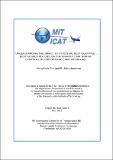| dc.description.abstract | New capabilities of Air Traffic Control (ATC) under development in Next Generation Air Transportation system (NextGen) will increase the system capacity to accommodate the expected growth in the air traffic. One of the key enablers of the NextGen capabilities is advanced onboard equipage of the aircraft. During the transition to NextGen, aircraft with different equipage levels will coexist in the same airspace: mixed-equipage. To reduce the mixed-equipage period, the Federal Aviation Administration (FAA) proposed “best-equipped, best-served policy” as a governing principle for accelerating NextGen equipage, offering incentives to the early adopters of NextGen avionics. However, the policy may introduce new tasks to the air traffic controllers, increasing the cognitive workload and decreasing the controller performance. The policy may be implemented at the strategic or the tactical level. This thesis identified two representative tactical level policies that may increase the difficulty and workload of the en-route air traffic controllers: best-equipped, first-served (BEFS) policy and best-equipped, exclusively served (BEES) policy. To investigate the impact of the potential tactical best-equipped, best-served policies on en-route controller performance and workload, a human-in-the-loop simulation was developed to compare the impacts of the two identified potential policies and the current first-come, first-served policy. The two potential tactical best-equipped, best-served policies provided marginal operational incentives to the NextGen equipage aircraft; however, the policies significantly increased the controller errors and reduced the total system efficiency with considerable delays to the less equipped aircraft compared to the current policy. In addition, higher subjective workload rating with the potential policies, especially during heavy traffic loads, indicated an increase in the controller workload and a reduction of the controller capacity. The analysis suggests that caution needs to be exercised when considering implementation of best-equipped best-served policy at the tactical level. Therefore, a strategic level implantation of the best-equipped, best-served policy is recommended; however, this study did not address impact of the strategic level implementation of the policy. | en_US |
